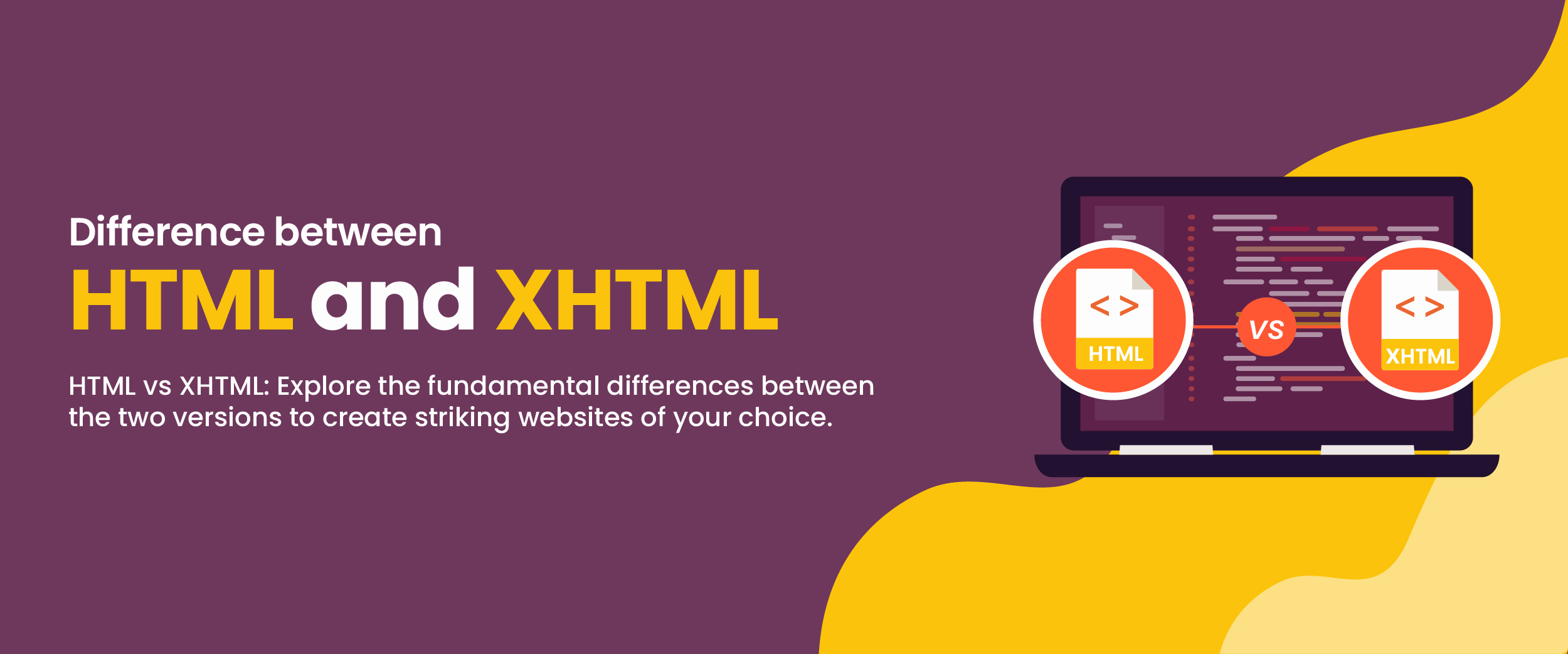Understanding the Difference between HTML and XHTML
Many people are unsure of the difference between HTML and XHTML since most websites use HTML (95.1%) while only a small number employ XHTML (6.2%). For us to make effective choices when working with these languages, it is crucial that we know what sets them apart from one another in terms of their syntaxes, features, advantages, or disadvantages. After reading this post, you will have an extensive understanding of both markup languages. This gives you all the essential information needed if you are looking to work on front-end development using either language.
What is HTML and XHTML?
HTML stands for Hypertext Markup Language. It is a language used to create websites and webpages that can be viewed on the Internet or an Intranet (a private network). Hypertext refers to the way in which information is linked from one page or website to another, allowing readers of a webpage easy navigation around related content without having to return to pages they have already visited.
XHTML is a programming language that improves upon HTML. It stands for Extensible Hypertext Markup Language and combines elements of XML with HTML to create something more powerful than regular HTML. XHTML makes it easier to read code and helps structure the code better while still being compatible with existing web development languages like hypertext markup language (HTML). In other words, it’s an enhanced version of ordinary HTML.
Get a confirmed ₹35,000 total stipend with our Full stack developer course with placement guarantee.
Key Difference between HTML and XHTML
If you’d love to know the HTML and XHTML differences, you might love to read on. The main differences between XHTML and HTML are:
| Difference | HTML | XHTML |
| Proper Closure of Elements | Closing tags are not always required | All elements must be properly closed |
| Proper Nesting of Elements | Nesting rules are flexible | Elements must be nested correctly |
| Lowercase Attribute Names | Case-insensitive | Case-sensitive |
| Attribute Minimization | Some attributes can be omitted | All attributes must have values |
| Closure of Empty Elements | Self-closing tags are optional | Empty elements must be closed with the ‘/’ symbol |
1. Proper Closure of XHTML Elements Is Necessary
To write valid XHTML, all of the elements must be properly closed. In other words, if an element such as a <h1> tag is opened first then it needs to also close at some point in the code; that means adding </h1>. An incorrect attempt would look something like this:
<h1>Hello there! How are you?
< h2 >I am good. What about you?
This isn’t valid and won’t render correctly because both tags never get formally closed off with respective closing tags -</ h1>, </ h2>. The correct way of writing it using proper closure looks like this:
<h1> Hello there! How are you? </h1>
<p> I am good. What about you ?</p>
Both HTML and XHTML follow the rule of requiring elements to be closed properly, but their syntaxes and flexibility are different. For example, in HTML some components don’t necessarily need closing tags (e.g., <be>) or can even self-close them (e.g., <br />), whereas with XHTML all opening tags must have a corresponding closure tag for each element used within it ( e.g.<h1>Hello</h1>).
2. Proper Nesting of XHTML Elements
XHTML elements must be nested correctly, meaning the tags that are opened first should also be closed in the same order. For example, if a <b> tag is opened before an <i> tag then they both need to close within each other; that is, </i></b>. An incorrect nesting would read as such:
<b><i>Hello! You are welcome here.</b></i>This isn’t valid XHTML and won’t render properly. The correct way of writing this statement using proper nesting would look like this:
<b><i> Hello! You are welcome here. </i></ b>Ensuring that opening and closing tags are correctly matched is a requirement of both HTML and XHTML for the elements to be properly nested.
3. Use Lowercase for XHTML Attribute Names
XHTML is a case-sensitive language, so all of the tags and attribute names must be in lowercase for them to render properly. This rule also applies to other elements like divs and paragraphs. A mistake someone might make when writing XHTML would look something like this:
<DIV> <P > Hey there! How are you? </ P >< / DIV>This isn’t valid because it’s written with capitalized letters rather than lowercase ones. The correct way of structuring that statement using proper casing looks as follows:
<div><p>Hey there! How are you?</ p></div>HTML is more forgiving than other languages since it allows attribute names to either be in uppercase or lowercase. However, the accepted convention is for them to be written in lowercase.
4. No Attribute Minimization in XHTML
In HTML, some attributes can be omitted if their default values are assumed. This is referred to as attribute minimization.
An example of this would be the checked attribute in:
<input type="checkbox"> This does not need a value specified. In XHTML, you cannot leave out the value of an attribute if it is specified.
For example, when making a checkbox with the name ‘gender’ and value ‘male’, just including “checked” without indicating what should be checked will not work – <input type=”checkbox” name-“gender” value “male” checked >. To make sure that your code complies with XHTML formatting rules, all attributes must have values included- so to signify something as being “checked” correctly in this format would look like this:
<input type="checkbox" name="gender" value="female" checked="checked" />5. Ensuring Proper Closure of Empty XHTML Elements
Empty elements, such as <hr> and <img>, must be properly closed for both HTML and XHTML. However, the syntax is slightly different; in HTML self-closure can occur by using one tag (e.g., <hr> or <img src=”image.jpg” alt=”image”>), while in XHTML a forward slash needs to precede the closing angle bracket (e.g.,< hr/> or < img src = ” image . jpg” alt= “image” />).
Empty elements in XHTML must always be closed with the ‘/’ symbol. These are tags like <hr> and<img>. An incorrect attempt to code this would look something like this:
<img src="google.jpg" alt="google" >
We welcome you!
<hr>
This isn’t valid because even though it’s an empty element, there needs to be a closure for it represented by /> after “alt=”. The correct way of writing that statement using proper closures looks as follows:
<img src="google.jpg" alt="google" />
We welcome you!
<hr/>
You can learn more about the difference between HTML and XTML by taking an online web development course.
The Features of HTML and XHTML
The major difference between HTML and XHTML is in their syntax. Both languages are used to create basic web pages, but XHTML is an improved version of HTML with stricter rules for how the code should be written. Their features include
- Support for multimedia such as images, video, audio, and animated graphics.
- Styling options using CSS (Cascading Style Sheets).
- Scripting capabilities with languages like JavaScript to add interactivity to web pages or applications.
- Forms that allow users to input data into webpages/applications that can be processed by a server-side script afterward;
- Tables used for displaying tabular data;
- Links allowing users to navigate between different web pages;
- Metadata provides information about the webpage or documents itself. i.e. authorship etc
HTML and XHTML are designed to help developers create websites that look great while remaining accessible for all users irrespective of the device or browser they’re using. These languages provide a set of tags that allow content to be structured, formatted, and displayed properly across any type of device. Additionally, HTML/XHTML also offers more advanced features such as supporting media elements like images or videos when needed.
Also, read our blog on features of HTML for better understanding.
Advantages of XHTML Over HTML
Here are some of the advantages of XHTML over HTML:
- XHTML is more structured and easier to read than HTML5 due to its stricter syntax, making it an ideal choice for developers who are building web pages from scratch.
- Following the rules of XML allows XHTML-based web pages to be interoperable across different browsers and devices
- XHTML is easy for other software tools such as applications or scripts to process since it’s simpler when compared with HTML5.
Disadvantages of XHTML against HTML
Despite the advantages, here are some disadvantages of XHTML:
- Compared to HTML5, coding with XHTML has a stricter syntax that can make it more difficult.
- As XHTML is not backward compatible with older versions of HTML, some web browsers may be unable to display its documents correctly.
- The bandwidth required for an XHTML document tends to be greater than the one needed by an HTML5 document due to its added tags and strict structure.
Conclusion
When it comes to the difference between HTML and XHTML, HTML (Hypertext Markup Language) is the code used to produce webpages and websites with hyperlinks that enable users to navigate through easily. XHTML (Extensible Hypertext Markup Language) uses both XML elements and standard HTML in order to improve its structure and syntax. While it has certain benefits like better readability as well as increased interoperability, there are also, some drawbacks to consider.






